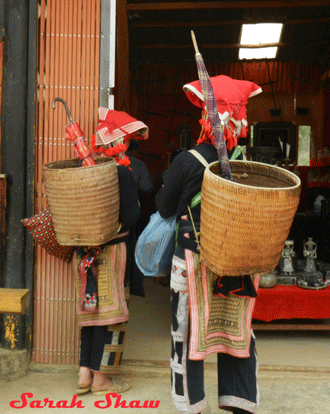 One of my favorite things about visiting southeast Asia is the chance to learn more about the indigenous people and their culture. In Vietnam alone, there are at least 54 different ethnic groups around the country. Each has its own traditions and identifying clothing. Last March, I stayed for a few days in the Sapa, in northwest Vietnam, which allowed me the chance to do a couple day hikes in the area. Walking through the hills terraced with rice paddies, as well as stopping in villages scattered along the way, gave me the opportunity to see daily life of the residents of Sapa. The main groups in the area are the Hmong, Dao (Yao,) Pho Lu, Giay and Tay.
One of my favorite things about visiting southeast Asia is the chance to learn more about the indigenous people and their culture. In Vietnam alone, there are at least 54 different ethnic groups around the country. Each has its own traditions and identifying clothing. Last March, I stayed for a few days in the Sapa, in northwest Vietnam, which allowed me the chance to do a couple day hikes in the area. Walking through the hills terraced with rice paddies, as well as stopping in villages scattered along the way, gave me the opportunity to see daily life of the residents of Sapa. The main groups in the area are the Hmong, Dao (Yao,) Pho Lu, Giay and Tay. 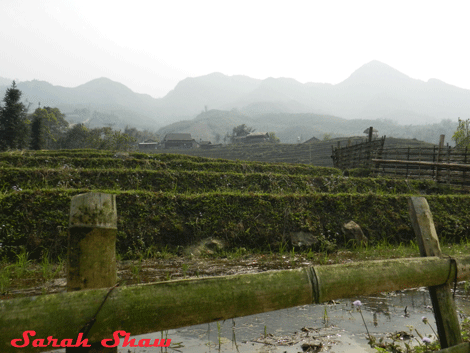
Sapa is located in the Hoang Lien Son mountain range which is the eastern most part of the Himalayas. This hilly terrain requires the people to create terraces for growing the staple crops of rice and corn. Rice, in particular, is a very time intensive crop and requires lots of hard work before a harvest. The people of the Sapa valley have benefited by increased tourism to the area since the 1990’s by both Vietnamese and foreigners who visit for the many trekking trails throughout the area.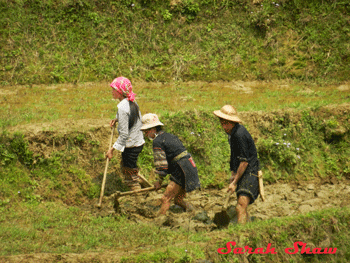
The Hmong and Dao women have taken advantage of visitors’ interest in their embroidery and clothing and now produce many articles specifically for tourists. While trekking through the area, many opportunities existed for me to purchase items created in the area. There are also numerous shops in Sapa where one can buy tribal souvenirs. Women also have stalls in the local market as well as setting up make-shift stores on blankets along the street. There is no shortage of opportunities to purchase local items in Sapa.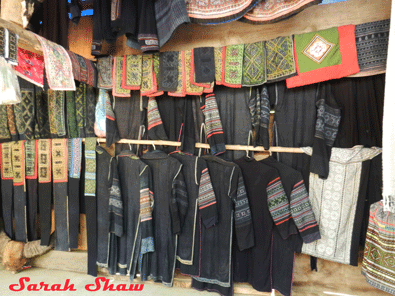
I found some of the vendors to be among the most assertive sellers I’ve ever come across in my travels of the world. Groups of women will station themselves outside of hotels and restaurants waiting for tourists to emerge when they will then very persistently offer whatever items they are carrying in their basket backpacks. Any response other than “no” will be taken as an encouragement that a deal is in the works. One purchase will trigger all the other women to expect that you will also buy something from them. During our treks, women would follow us along the entire way offering items for sale, planning on wearing down our resolve over the miles and hours. I suggest that you be firm in your response to them and consistent. If this persistence is rewarded with eventual purchases, this behavior will continue and I think become even worse over time. I absolutely encourage you to purchase items you want and to support these women who so badly need income, I just feel that it needs to be done when they are being respectful of you as well, so that the right behaviors are being reinforced.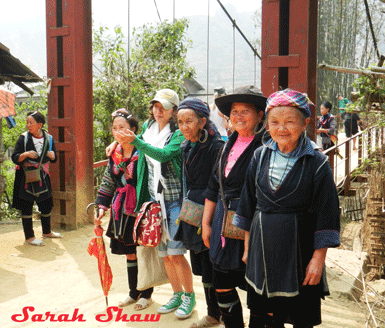
Hiking through the Sapa valley was a breathtaking experience. The countryside is so beautiful, lush and green. The terraces snaking through the valley are incredibly photogenic. Both mornings I went for a walk began with the lower parts of the valleys shrouded in fog. As the morning wore on, the fog burned off and the view became even more magnificent. I regularly came across people hard at work cultivating
the earth or harvesting some vegetables from the garden beside their home. Ducks were everywhere enjoying the flooded rice fields. I also came across a number of pigs strolling through their village with little piglets trailing behind. One family I really enjoyed meeting was a chicken with a brood of orphaned ducklings she had taken over as her own. They searched together for bugs along the side of the road.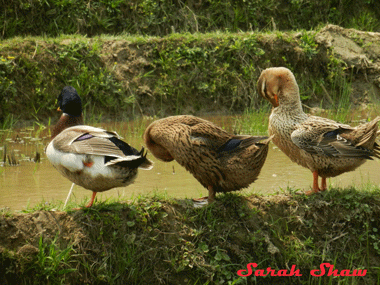
At regular intervals along the trail, on my first day, were shops featuring creations from the area. One was a workshop of carvers working with stone creating sculptures and ornamental urns. Other shops were loaded with embroidered jackets and woven skirts similar to those seen on the local women. There were so many to choose from and they were beautiful and colorful examples of the skill each woman possesses passed down through the generations from their mothers and grandmothers.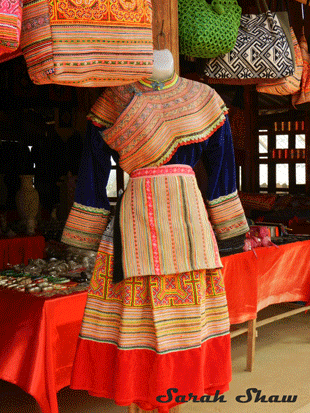
On the second day, we hiked to a local waterfall. The trail there was covered with stalls offering souvenirs including many jackets, skirts, baby carriers and aprons to accessorize just like a local woman would. In addition, there were many quilts for sale. As there are so many opportunities for purchasing these handicrafts, I suggest that you do some research on your preferences before buying. For example, with the quilts, some are made entirely by hand and are covered in tiny cross-stitched embroidery of the Hmong and take countless hours to produce. However there are also even more quilts that have printed fabrics interspersed with strips of handwork. These quilts are faster, easier and cheaper to create and should be priced lower than the genuine articles. Be sure to study up and examine the items closely to ensure you are getting what you are paying for. I would suggest that you price out many of them so you get an idea of the going rate before you make an investment. These quilts will not be cheap, nor should they be with the time it takes to create them. You should also expect to bargain for them. I purchased an entirely hand embroidered one in the market in Sapa for around $150 but the negotiation for it took place over several days and a fellow traveler also bought one at the same time so we were able to get a lower price for buying them together.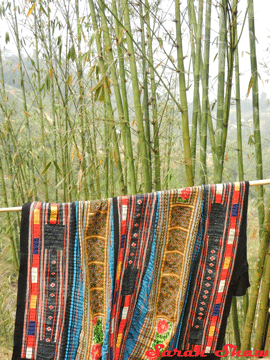
Sapa and its surrounding valleys are a really special place to visit in Vietnam. They are easy to access on an overnight train from Hanoi and then an hours drive. The area is rich with culture, trekking and shopping opportunities. As usual, I have many special photographs from my hikes in the area and have added additional pictures to the Vietnam photo album on the WanderShopper Facebook Fan Page. Please visit and check them out. While you are there, “like” WanderShopper so you can be alerted when special Facebook only photos are posted in the future. Also be on the lookout for future posts from this beautiful area on other clothing and jewelry shopping opportunities in the months to come.